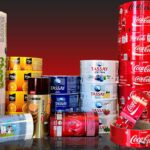In today’s fast-paced world, the demand for high-quality and efficient printing solutions is ever-growing. One of the most prevalent methods used in the printing industry is web offset printing. This technique is not only critical for producing large volumes but also ensures exceptional print quality. Let’s delve into the intricacies of this process and why it holds such a pivotal role in modern marketing strategies.

Understanding Web Offset Printing
Web offset printing is a popular printing method that uses continuous rolls of paper, known as webs. Unlike sheet-fed printing, which uses individual sheets, web offset printing is ideal for high-volume printing runs, such as newspapers, magazines, and catalogs. It’s renowned for its efficiency, speed, and cost-effectiveness, making it indispensable for businesses that require large-scale print productions.
The Mechanics of Web Offset Printing
The process begins with the paper web being fed through a series of rollers. The printing plates, typically made of aluminum, transfer the ink onto a rubber blanket and then onto the paper, ensuring a clean and precise print. This indirect method is what distinguishes offset printing from other printing techniques, as it minimizes wear and tear on the printing plates.
Advantages of Web Offset Printing
One of the primary advantages of web offset printing is its ability to produce high-quality prints at a rapid pace. This method is highly cost-effective for large print runs, as the cost per page decreases significantly with volume. Additionally, the technique offers excellent color fidelity and image clarity, which are crucial for marketing materials.
Applications in Marketing
In the realm of marketing, the quality of printed materials can significantly impact a brand’s image. Web offset printing is often used for producing marketing collateral such as brochures, flyers, and direct mailers. The high-quality output ensures that the brand’s message is communicated effectively and professionally.
Customization and Flexibility
Despite being a mass-production method, web offset printing offers a degree of customization. Marketers can choose from a variety of paper types, inks, and finishes to tailor their print materials according to specific campaign needs. This flexibility allows for creative freedom while maintaining cost efficiency.
Speed and Efficiency
In today’s competitive market, time is of the essence. The speed at which web offset printing operates is unparalleled, allowing businesses to meet tight deadlines without compromising on quality. This efficiency is particularly beneficial during peak marketing seasons when the demand for printed materials surges.
Environmental Considerations
With growing awareness of environmental issues, many companies are seeking sustainable printing solutions. Web offset printing can be environmentally friendly when using recycled paper and soy-based inks. Additionally, advancements in technology have led to more efficient machines that reduce waste and energy consumption.
Challenges and Considerations
While there are numerous benefits, it’s important to acknowledge the challenges associated with web offset printing. The initial setup costs can be high, and it’s not always the best option for small print runs. However, for businesses that require large volumes, the long-term savings and quality make it a worthwhile investment.
Comparing with Other Printing Methods
When deciding on a printing method, it’s essential to compare web offset printing with other techniques like digital and flexographic printing. Each method has its strengths and weaknesses, and the choice often depends on the specific requirements of the print job. For more insights, you can explore the explained offset lithography to understand the nuances better.
Digital Printing vs. Web Offset Printing
Digital printing is known for its flexibility and ability to produce small print runs with variable data. However, when it comes to high-volume jobs, web offset printing remains the more cost-effective choice. The decision largely hinges on the size and nature of the print job.
Flexographic Printing vs. Web Offset Printing
Flexographic printing is often used for packaging and labels. While it excels in printing on a variety of substrates, web offset printing is superior in delivering high-quality images and text. To learn more about flexographic printing, visit the ink drying systems in flexo section.
Future of Web Offset Printing
As technology continues to evolve, so too does the landscape of web offset printing. Innovations in automation and digital integration are set to enhance the efficiency and capabilities of this printing method, making it even more appealing to the marketing industry.
Conclusion
In conclusion, web offset printing remains a cornerstone in the world of printing, especially within the marketing sector. Its ability to produce high-quality, cost-effective prints at scale makes it an invaluable asset for businesses aiming to leave a lasting impression. As the industry continues to innovate, those who leverage this technology will likely stay ahead in the competitive landscape.

Frequently Asked Questions
What is web offset printing best used for?
Web offset printing is best used for high-volume print runs, such as newspapers, magazines, and catalogs, where quality and cost-efficiency are paramount.
How does web offset printing differ from digital printing?
Web offset printing is more cost-effective for large-scale jobs, whereas digital printing is ideal for smaller runs with customizable data.
Is web offset printing environmentally friendly?
Yes, when using recycled paper and eco-friendly inks, web offset printing can be a sustainable choice.
For a deeper dive into the specifics of offset printing, you can check this external resource on offset printing.
This article contains affiliate links. We may earn a commission at no extra cost to you.






